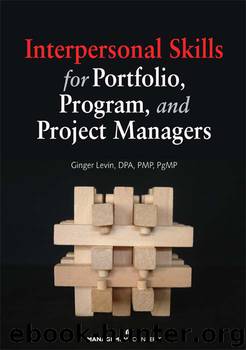Interpersonal skills for portfolio program and project managers by Levin Ginger

Author:Levin, Ginger [Levin, Ginger]
Language: eng
Format: epub
ISBN: 9781567262889
Publisher: Management Concepts Press
Published: 2010-08-01T05:00:00+00:00
Communicating with Stakeholders
In a matrix environment, the project manager must communicate with team members and their functional managers to ensure that there is a clear understanding of the role each team member will play, when the team member will be needed, and how the team member‧s work will be evaluated. If the functional manager is reluctant to let the team member join the project, the project manager should point out any common areas of interest and how the project can help the team member develop new skills that then will be useful to his or her functional team when he or she completes the specific assignment. Focus on building a partnership with the functional manager based on mutual trust, and involve the functional manager and his or her staff in key decisions involving the project beyond the need for resources.
As the project manager, you should recognize that the functional manager may think that you are encroaching on his or her assigned resources. If you have not built a positive relationship with the functional manager, he or she may act as an obstacle—for example, by mandating complete compliance with all technical requirements. This factor alone makes the functional manager a critical stakeholder. Establishing a long-term relationship with him or her is vital.
Karlsen (2002) notes that certain stakeholders control needed resources for the program or project and explains that each stakeholder has different ideas about what constitutes the success of a program or project because each stakeholder‧s interests are different. Frooman (1999) says that stakeholders may withhold resources or attach constraints to what the resources are allowed to do to exert their influence or even change the overall intent of the program, the project, or the organization.
If the project has only one customer, serve as the liaison to the customer and provide regular information. Actively listen to understand the customer‧s point of view, and point out any opportunities that the project team has noticed for the customer to improve its processes, even if they do not apply directly to the project. Obviously, these suggestions must be subtle. You do not want the customer to think that you are telling it how to do its work. You simply want to explain that you see an area in which the customer might be able to make a small improvement that will enable it to excel in its field. If the customer is receptive, you have set the stage for a closer relationship, one in which you as the project manager are viewed as a valued partner, rather than just the person who is responsible for the current project.
If there are multiple customers, consider making a team member responsible for interacting regularly with each one. Make sure to communicate directly with each one; do not expect them to communicate among themselves, even if they are in the same organization.
Show each stakeholder that you are interested in compromising as much as possible when decisions are required on key project issues, and regularly solicit ideas from stakeholders about ways you can foster continuous improvement on your project.
Download
This site does not store any files on its server. We only index and link to content provided by other sites. Please contact the content providers to delete copyright contents if any and email us, we'll remove relevant links or contents immediately.
Hit Refresh by Satya Nadella(8819)
The Compound Effect by Darren Hardy(8440)
Change Your Questions, Change Your Life by Marilee Adams(7320)
Nudge - Improving Decisions about Health, Wealth, and Happiness by Thaler Sunstein(7190)
The Black Swan by Nassim Nicholas Taleb(6719)
Deep Work by Cal Newport(6488)
Daring Greatly by Brene Brown(6189)
Rich Dad Poor Dad by Robert T. Kiyosaki(6109)
Principles: Life and Work by Ray Dalio(5872)
Man-made Catastrophes and Risk Information Concealment by Dmitry Chernov & Didier Sornette(5591)
Digital Minimalism by Cal Newport;(5325)
Playing to Win_ How Strategy Really Works by A.G. Lafley & Roger L. Martin(5309)
Big Magic: Creative Living Beyond Fear by Elizabeth Gilbert(5302)
The Myth of the Strong Leader by Archie Brown(5204)
The Slight Edge by Jeff Olson(5174)
Discipline Equals Freedom by Jocko Willink(5134)
The Motivation Myth by Jeff Haden(4965)
Stone's Rules by Roger Stone(4818)
The Laws of Human Nature by Robert Greene(4724)
